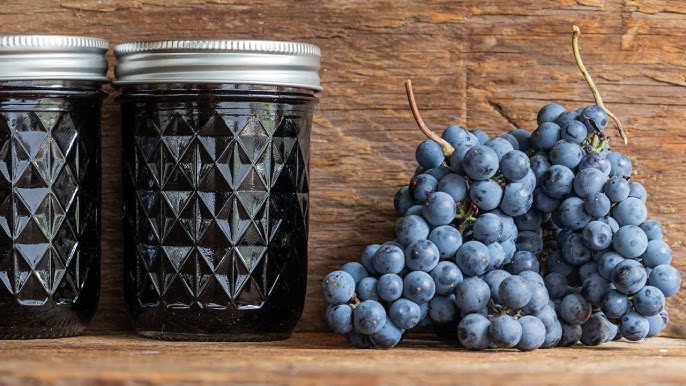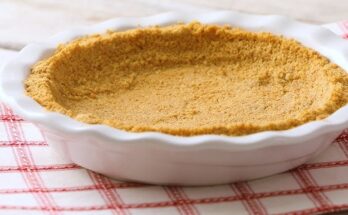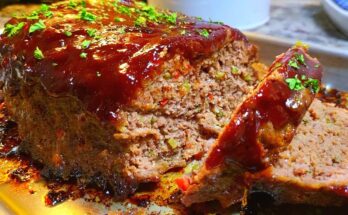Grape Jam Recipe: Craving a jar of sweet, fruity goodness to spread on your toast in the morning or swirl into your yogurt? Nothing beats the flavor of a homemade grape jam—thick, juicy, and loaded with rich, fruity notes. Whether you’re a seasoned jam maker or a total beginner, this step-by-step guide is your ultimate roadmap to creating a jam so good you’ll never want to go store-bought again.
Let’s face it—store-bought jam often comes packed with preservatives, artificial flavors, and way too much sugar. But when you make grape jam at home, you control everything: the sweetness, the texture, even the flavor combos. And the best part? It’s easier than you think.
This guide will walk you through every single step—from choosing the right grapes to preserving the jam in jars—so you end up with a jam that’s rich, smooth, and 100% homemade. So roll up your sleeves. It’s jam time!
Why Make Homemade Grape Jam?
There’s something deeply satisfying about preserving your own food, especially when it turns into something as sweet and delicious as grape jam. But why go the DIY route when you can easily grab a jar from the store?
Here’s why:
- Flavor Explosion: Homemade jam tastes so much fresher. The grapes are simmered slowly, allowing their natural sugars and juices to shine without being masked by artificial flavors or over-processing.
- No Preservatives: Say goodbye to those hard-to-pronounce additives. When you make your own, you use simple, natural ingredients.
- Customize It Your Way: Like your jam less sweet? Want to add vanilla or cinnamon? You get total creative freedom.
- Cost-Effective: Bought grapes in bulk? Making jam is a brilliant way to use them before they go bad.
- Perfect for Gifting: A cute jar of homemade grape jam makes a thoughtful and impressive gift, especially when dressed up with a label and ribbon.
Still not convinced? Try it once—you’ll never look back.
What’s the Difference Between Jam, Jelly, and Preserves?
People often use these terms interchangeably, but they’re not the same thing. Knowing the difference helps you understand what you’re making (and what you’re not!).
- Jam: Made from crushed fruit and sugar. It has a thick, spreadable consistency with little chunks of fruit.
- Jelly: Made from fruit juice only. It’s clear and smooth, with no fruit bits.
- Preserves: Made with whole or large chunks of fruit suspended in a syrup or gel.
This guide focuses on jam, which is the perfect blend of pulpy, juicy fruit and a luscious, spreadable texture. Not too smooth, not too chunky—just right.
Best Grapes for Making Jam
Not all grapes are created equal—especially when it comes to jam making. The best varieties bring bold flavor and a balance of sweet and tart. Here’s a look at the top choices:
Concord Grapes
- Taste: Bold, aromatic, and very grape-y.
- Color: Deep purple.
- Texture: Juicy with thick skins.
- Perfect for: Classic grape jam with that nostalgic taste.
Red Seedless Grapes
- Taste: Milder, less tangy.
- Color: Ruby red.
- Texture: Smooth and sweet.
- Perfect for: Sweeter, dessert-style jams.
Green Grapes
- Taste: Tart and crisp.
- Color: Pale green or yellow.
- Texture: Firm.
- Perfect for: Tart jams or pairing with spices like ginger or cardamom.
Tip: Use fully ripe grapes for maximum sweetness and flavor. Underripe grapes can make the jam too sour.
Tools and Equipment You’ll Need
Before you dive into the cooking process, make sure your kitchen is equipped for the job. Here’s what you’ll need:
- Large stockpot or jam pan – For cooking the grapes
- Wooden spoon – Stirring without scratching
- Potato masher – To crush grapes
- Fine mesh strainer or food mill – Optional, for removing skins or seeds
- Sterilized glass jars with lids – For storing the jam
- Jar funnel – Makes pouring jam into jars mess-free
- Tongs or jar lifter – For handling hot jars
- Candy thermometer or plate test – To check gelling point
- Ladle – For scooping hot jam
Having everything ready ahead of time keeps the process smooth and stress-free.
List of Ingredients You’ll Need
Let’s keep it simple. This grape jam recipe uses just a few natural ingredients:
- 4 cups of fresh grapes (Concord or any of your choice) – Washed and de-stemmed
- 1.5 to 2 cups of granulated sugar – Adjust to taste
- 2 tablespoons of lemon juice – Helps with preservation and gelling
- 1/2 teaspoon of butter (optional) – Reduces foaming
That’s it. No pectin needed. Grapes are naturally high in pectin, so they’ll gel beautifully on their own when cooked properly.
How to Prepare the Grapes
Preparation is key to a smooth cooking process. Here’s how to get your grapes jam-ready:
- Wash thoroughly: Grapes can carry a waxy coating or pesticide residue. Rinse them in a colander under cold water.
- De-stem: Remove all stems. They’re bitter and don’t break down during cooking.
- Check for ripeness: Discard any grapes that are moldy, too soft, or underripe.
- Optional: If using Concord grapes, you can separate the skins from the pulp for a richer color and smoother texture.
This step may take a bit of time, but don’t skip it—it sets the foundation for a clean, flavorful jam.
Step-by-Step Guide to Making Grape Jam
Alright, time to get cooking! Follow this process carefully and you’ll end up with jars of jammy perfection.
1. Washing and De-stemming
Start by giving your grapes a thorough rinse. Pluck each one off its stem and discard any bad ones.
2. Cooking the Grapes
Place the grapes in a large pot and turn the heat to medium. Stir frequently as the grapes begin to release their juices. Use a potato masher to gently crush them.
Let them simmer for about 10-15 minutes, until soft and juicy.
3. (Optional) Separate Skins and Seeds
If you’re working with seeded or thick-skinned grapes, pour the mixture through a food mill or mesh strainer to remove seeds and skins. If not, move to the next step.
4. Add Sugar and Lemon Juice
Return the strained pulp to the pot. Add your sugar and lemon juice. Stir to combine.
Pro tip: Start with 1.5 cups of sugar, taste after it simmers, and add more if needed.
5. Simmer Until Thickened
Bring the mixture to a low boil and let it simmer uncovered. Stir occasionally so it doesn’t burn. Skim off any foam that forms (a little butter helps reduce this).
This step takes around 30-45 minutes. The jam will darken and thicken as it reduces.
6. Test for Gel Stage
Use the plate test: Drop a small spoonful on a cold plate and push it with your finger. If it wrinkles slightly, it’s ready. You can also use a thermometer—jam sets at 220°F (104°C).
Once you hit that point, remove it from the heat immediately.
How to Sterilize Jars for Canning
Sterilizing your jars isn’t just a formality—it’s a must. Properly sterilized jars prevent the growth of bacteria, molds, and yeasts that could spoil your beautiful jam. Here’s a step-by-step breakdown:
- Wash the Jars and Lids
Start with clean jars and lids. Use hot, soapy water and rinse thoroughly. Make sure there’s no grease or food residue stuck inside or around the rim. - Boil the Jars
Place the jars (not the lids) in a large pot of boiling water. Make sure the jars are fully submerged and boil them for at least 10 minutes. If you’re at a higher altitude, add an extra minute for every 1,000 feet above sea level. - Keep Them Hot
Keep the jars in the hot water until you’re ready to fill them. Cold jars filled with hot jam can crack, so it’s essential they stay warm. - Sterilize the Lids
Don’t boil the lids—just submerge them in hot (not boiling) water for a few minutes. Most modern lids have a rubber seal that can be damaged by boiling. - Drain Before Use
Use tongs to lift jars out of the water and place them upside down on a clean towel to drain for a moment. Don’t towel dry—this could introduce lint or bacteria.
Once everything’s ready, it’s time to fill those jars!
How to Can Grape Jam for Long-Term Storage
You’ve made a luscious batch of grape jam. Now let’s preserve it so you can enjoy it for months! Here’s the step-by-step for water bath canning:
- Fill the Jars
Use a funnel to ladle hot jam into each jar, leaving about 1/4-inch of headspace (that’s the space between the top of the jam and the rim of the jar). - Remove Air Bubbles
Run a butter knife or plastic spatula around the inside edge of the jar to release any trapped air bubbles. This ensures a good seal. - Wipe the Rims
Dip a clean towel in hot water and wipe the rims of each jar. Even a tiny drop of jam on the rim can prevent the lid from sealing properly. - Apply Lids and Rings
Place a sterilized lid on each jar and screw on the ring until it’s “fingertip tight.” Don’t over-tighten. - Process in Boiling Water
Lower the jars into a water bath canner or large pot filled with boiling water. Make sure the water covers the jars by at least an inch. Process for 10–15 minutes, depending on your altitude. - Cool and Seal
Carefully remove the jars with tongs and place them on a towel-lined counter. You’ll hear that satisfying “pop” as they cool, indicating a proper seal. Let them sit undisturbed for 12–24 hours. - Check the Seal
Press the center of each lid. If it doesn’t move, you’ve got a seal. If it pops up and down, refrigerate that jar and eat it first.
Properly canned grape jam can last up to 1 year in a cool, dark place!
Tips for Making the Best Grape Jam
Let’s take your jam game from “good” to “oh-my-god-this-is-amazing” with a few pro tips:
- Use Fully Ripe Grapes: Overripe grapes are too mushy and underripe ones are too tart. Aim for grapes that are plump and sweet with a little firmness.
- Don’t Skip the Lemon Juice: It’s not just for flavor—lemon juice helps with preservation and gelling by balancing the pH.
- Mash While Heating: Crushing the grapes while they cook helps release their juice and natural pectin faster.
- Use a Wide Pot: A wide base speeds up evaporation and helps your jam reduce faster and more evenly.
- Watch the Heat: Don’t blast it on high the whole time. A rolling boil is good, but too much heat can scorch the sugars and affect the taste.
- Skim That Foam: You’ll see a foamy layer on top—skim it off with a spoon for a clearer, cleaner-tasting jam.
Remember, jam-making is part science, part art. Don’t be afraid to experiment, but stick to the basics until you’ve got a few batches under your belt.
Common Mistakes to Avoid
Even seasoned jam makers make slip-ups. Here are the most common mistakes to watch for—and how to dodge them:
- Using Too Much Sugar or Too Little: Too much sugar can overpower the grape flavor; too little may cause spoilage or make the jam runny.
- Not Testing for Gel Stage: If you undercook it, your jam will be syrupy. Overcook it, and it’ll be stiff and sticky. Do the plate test or use a thermometer.
- Skipping Sterilization: Dirty jars = spoiled jam. Always sterilize.
- Improper Storage: Storing in a warm place or direct sunlight will degrade the jam faster. Keep it cool and dark.
- Not Removing Air Bubbles: Trapped air can mess with the seal and lead to mold.
- Filling Cold Jars: Cold jars plus hot jam equals cracked glass. Always keep jars warm before filling.
Avoid these and you’re golden.
Creative Variations to Try
Want to jazz up your basic grape jam? Try these tasty twists:
Grape & Vanilla Bean Jam
- Add 1 split vanilla bean while cooking your grapes.
- Remove before jarring.
- The vanilla brings out a smooth, dessert-like flavor.
Spiced Grape Jam
- Toss in a cinnamon stick, a couple cloves, or a piece of star anise while the jam simmers.
- It’s like Christmas in a jar.
Grape & Ginger Jam
- Add 1 tablespoon of finely grated fresh ginger for a spicy kick.
Low-Sugar or Sugar-Free Grape Jam
- Use a natural sweetener like stevia or honey.
- Keep in mind: Without sugar, it won’t preserve as long. Refrigerate and use within 1 month.
How to Store Homemade Grape Jam
Once your jars are sealed and cooled, proper storage is key to keeping your jam fresh and delicious:
- Pantry Storage: Store sealed jars in a cool, dark place. They’ll last up to 12 months.
- Fridge Storage: Once opened, a jar will stay good in the fridge for 3–4 weeks.
- Freezing Option: You can also freeze jam in freezer-safe containers—just leave some space for expansion.
Label Everything: Always write the date you made it on the jar lid or label. Trust me, you’ll thank yourself later when you have five mystery jars on the shelf!
Fun Ways to Use Grape Jam
Sure, toast is the classic option—but grape jam can do so much more.
Breakfast Ideas
- Spread it on pancakes or waffles.
- Stir into oatmeal or yogurt.
- Top a bagel with cream cheese and a dollop of jam.
Baking & Desserts
- Use as a filling in thumbprint cookies or layer cakes.
- Swirl into cheesecake batter for a fruity twist.
- Spoon over vanilla ice cream.
Savory Pairings
- Serve with cheese on a charcuterie board.
- Glaze over grilled chicken or pork.
- Mix into a balsamic vinaigrette for salads.
The options are only limited by your imagination (and your willpower).
Nutritional Benefits of Grapes and Homemade Jam
While jam is a sweet treat, homemade versions made from fresh grapes offer a few nutritional bonuses:
- Grapes are rich in antioxidants like resveratrol, which supports heart health.
- Natural sugars in fruit are easier on your system than processed sugar.
- Homemade jam = fewer additives, preservatives, and chemicals.
- Lemon juice adds vitamin C, which supports immunity and acts as a natural preservative.
Of course, moderation is key. Jam is still high in sugar, but when it’s homemade, it’s a far better option than many store-bought alternatives.
FAQs about Grape Jam Recipe
1. Can I use frozen grapes for this recipe?
Absolutely! Just thaw them completely and drain any excess water before starting.
2. Do I need pectin to make grape jam?
Nope! Grapes are naturally high in pectin, so as long as you simmer them properly, the jam will set without added pectin.
3. How long does homemade grape jam last?
Properly canned and sealed, it lasts up to 1 year in a cool, dark place. Once opened, refrigerate and use within 3–4 weeks.
4. Can I reduce the sugar or use honey instead?
Yes, but remember that sugar also acts as a preservative. Less sugar or alternative sweeteners may affect shelf life and consistency.
5. My jam didn’t set—what can I do?
You can re-boil it and test for the gel stage again. Sometimes it just needs more cooking time to thicken.
Conclusion
Making grape jam at home is like bottling up sunshine and sweetness. From selecting ripe grapes to sealing your final jar, it’s a process that rewards your patience and effort with something truly special. Whether you’re spreading it on toast, gifting it to friends, or enjoying it by the spoonful (no judgment), there’s nothing quite like the taste of homemade jam.
So grab some grapes, roll up your sleeves, and get jamming. Your toast—and your tastebuds—will thank you.



